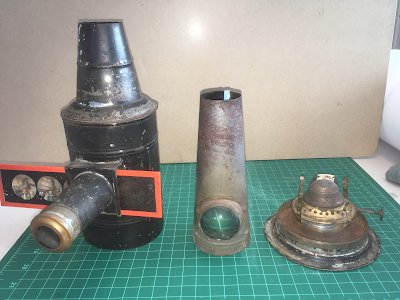 |
| My magic lantern, with its orange-bordered glass slide in place. You just slide it sideways by hand to change the image. |
I have a fascination with pre-electric home entertainment that people enjoyed before they could flip a switch. For example, I love old-timey spring-cranked phonographs and 3-D stereo viewers. With that in mind, last weekend's antique-store find was a charming old magic lantern--basically a flame-illuminated slide projector--plus 12 glass slides in their original box!
This magic lantern isn't marked so I don't know much about it. Some people's parlors had fancy ones, gleaming with fine wood cases and brass fittings, but I think mine is more on the cheap-children's-toy end of the scale. The slide box has no date clues. Magic lanterns have a long history, dating from the 1600s through the 1920s or so. Folks used to go to magic lantern shows in theaters. Just based on the style of the slides' artwork and some context clues--i.e., drawings of ships and bicycles but no autos or aircraft--I think I'm looking at late 19th or very early 20th century. Hard to tell.
Light was provided by an oil- or alcohol-burning wick inside a lensed cone, which is nested inside a housing that holds the slides and a second lens. A chimney (still quite sooty inside) carried away heat and smoke. Not wanting to set my house on fire (again), I hung a small LED inside the chimney where the flame would have been, which works great! I just tried it out in a dark closet, and projected a nicely focused image maybe 6 feet. Farther = dimmer.
Part of what so grips me about these technologies is how clever they were, and how much fun they were, without electricity. I also like to imagine someone having the first phonograph or stereo viewer or magic lantern in the neighborhood. What a thrilling thunderclap it must have been to suddenly have recorded music, or 3D photos of exotic locales, or drawings glowing on the wall! What a world-expanding eye-opener!


No comments:
Post a Comment